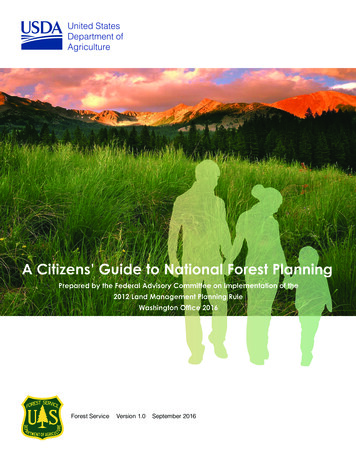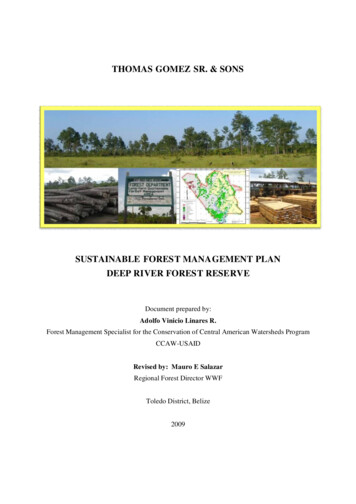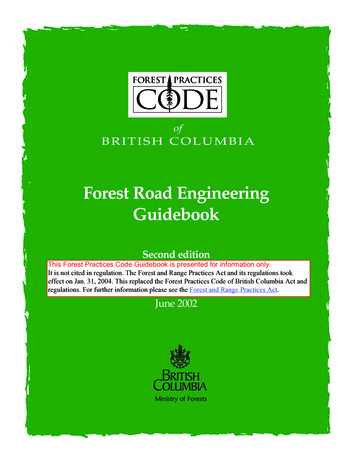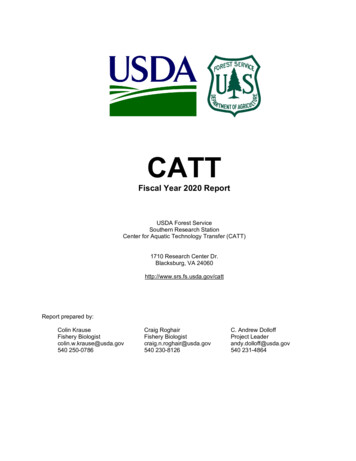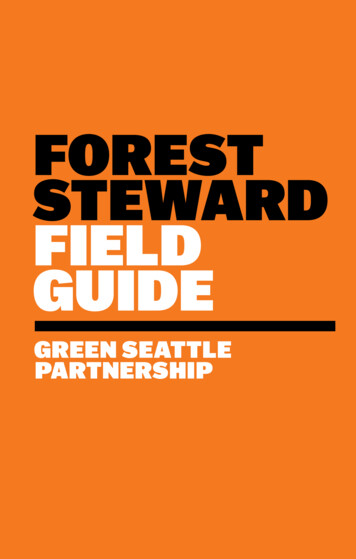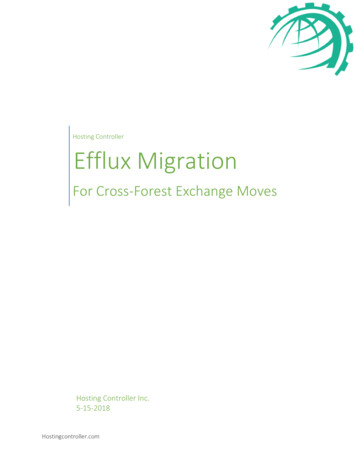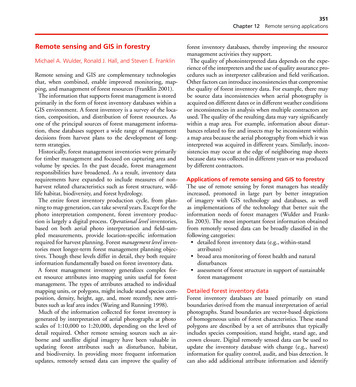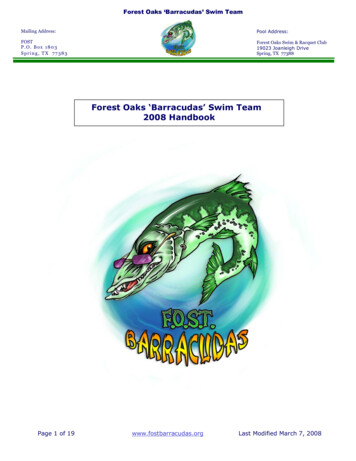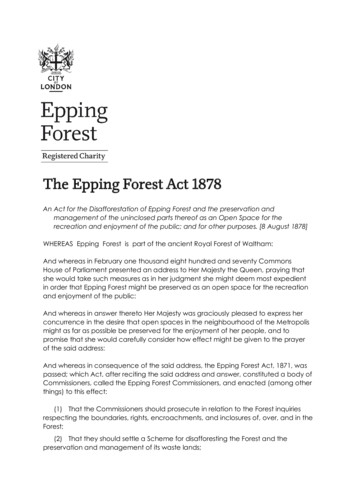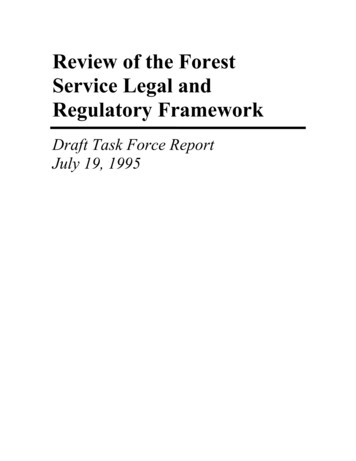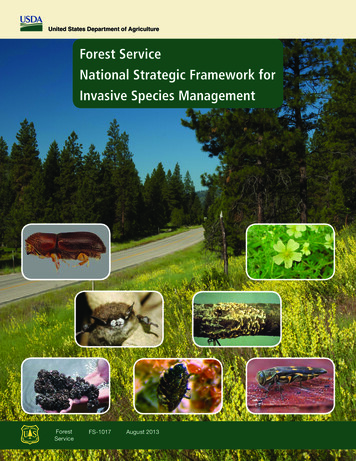
Transcription
United States Department of AgricultureForest ServiceNational Strategic Framework forInvasive Species ManagementForestServiceFS-1017August 2013
Front cover photo credits:Background Image: U.S. Department of Agriculture (USDA), PhotographyBrown Bat: Ryan von Linden/New York Department of Environmental ConservationGold Spotted Oak Borer: Mike Lewis, Center for Invasive Species Research, http://www.bugwood.orgHemlock Woolly Adelgid: Michael Montgomery, USDA Forest Service, http://www.bugwood.orgSulfur Cinquefoil: Richard Old, XID Services, Inc.Walnut Twig Beetle: Steven Valley, Oregon Department of Agriculture, http://www.bugwood.orgWhite Pine Blister Rust: USDA Forest Service, http://www.bugwood.orgZebra Mussel: Minnesota Department of Natural ResourcesBack cover photo credits:Background Image: Bob Schroeter, USDA Forest ServiceAsian Longhorned Beetle: Melody Keena, USDA Forest Service, http://bugwood.orgEmerald Ash Borer: David Cappaert, Michigan State University, http://www.bugwood.orgGypsy Moth Larvae: E. Bradford Walker, Vermont Department of Forests, Parks and Recreation, http://www.bugwood.orgHemlock Woolly Adelgid: Mark McClure, Connecticut Agricultural Experiment Station (retired), http://www.bugwood.orgKudzu: USDA Forest ServiceTree of Heaven: Chuck Bargeron, University of Georgia, http://www.bugwood.orgTrout: Michael K. Young, USDA Forest Service
ContentsExecutive Summary . . . . . . . . . . . . . . . . . . . . . . . . . . . . . . . . . . . . . . . . . . . . . . . . . . . . . . . . . . . . . . . . . . 4Introduction . . . . . . . . . . . . . . . . . . . . . . . . . . . . . . . . . . . . . . . . . . . . . . . . . . . . . . . . . . . . . . . . . . . . . . . . 5Responsibilities and Capabilities of the Forest Service. . . . . . . . . . . . . . . . . . . . . . . . . . . . . . . . . . . . . . 5Vision . . . . . . . . . . . . . . . . . . . . . . . . . . . . . . . . . . . . . . . . . . . . . . . . . . . . . . . . . . . . . . . . . . . . . . . . . 5Purpose of the Framework. . . . . . . . . . . . . . . . . . . . . . . . . . . . . . . . . . . . . . . . . . . . . . . . . . . . . . . . . 6Framework Organization. . . . . . . . . . . . . . . . . . . . . . . . . . . . . . . . . . . . . . . . . . . . . . . . . . . . . . . . . . . 6National and Regional Invasive Species Program Organization . . . . . . . . . . . . . . . . . . . . . . . . . . . . . . 6Local Network and Organization . . . . . . . . . . . . . . . . . . . . . . . . . . . . . . . . . . . . . . . . . . . . . . . . . . . . 6Invasive Species Systems Approach . . . . . . . . . . . . . . . . . . . . . . . . . . . . . . . . . . . . . . . . . . . . . . . . . . . . . 7Invasive Species Systems Approach Elements . . . . . . . . . . . . . . . . . . . . . . . . . . . . . . . . . . . . . . . . . . . 7Element 1.—Prevention . . . . . . . . . . . . . . . . . . . . . . . . . . . . . . . . . . . . . . . . . . . . . . . . . . . . . . . . . 8Element 2.—Detection. . . . . . . . . . . . . . . . . . . . . . . . . . . . . . . . . . . . . . . . . . . . . . . . . . . . . . . . . . 9Element 3.—Control and management. . . . . . . . . . . . . . . . . . . . . . . . . . . . . . . . . . . . . . . . . . . . . 10Element 4.—Restoration and rehabilitation. . . . . . . . . . . . . . . . . . . . . . . . . . . . . . . . . . . . . . . . . . 11Guiding Principles . . . . . . . . . . . . . . . . . . . . . . . . . . . . . . . . . . . . . . . . . . . . . . . . . . . . . . . . . . . . . . . . . . 13Summary . . . . . . . . . . . . . . . . . . . . . . . . . . . . . . . . . . . . . . . . . . . . . . . . . . . . . . . . . . . . . . . . . . . . . . . . . . 15Framework in Action . . . . . . . . . . . . . . . . . . . . . . . . . . . . . . . . . . . . . . . . . . . . . . . . . . . . . . . . . . . . . . . . 16Appendixes . . . . . . . . . . . . . . . . . . . . . . . . . . . . . . . . . . . . . . . . . . . . . . . . . . . . . . . . . . . . . . . . . . . . . . . . 29Appendix A: Invasive Species Systems Approach (ISSA), ISSA Guiding Principles,and ISSA Roles and Responsibilities . . . . . . . . . . . . . . . . . . . . . . . . . . . . . . . . . . . . . . . . . . . . . . . 29Appendix B: Invasive Species Issue Teams . . . . . . . . . . . . . . . . . . . . . . . . . . . . . . . . . . . . . . . . . . . . . 31Appendix C: Glossary . . . . . . . . . . . . . . . . . . . . . . . . . . . . . . . . . . . . . . . . . . . . . . . . . . . . . . . . . . . . 32Appendix D: References . . . . . . . . . . . . . . . . . . . . . . . . . . . . . . . . . . . . . . . . . . . . . . . . . . . . . . . . . . 34National Strategic Framework for Invasive Species Management3
Executive SummaryInvasive species pose some of the greatest environmentaland economic threats to the Nation’s forests, grasslands,and waterways. To ensure the continued production ofneeded goods, services, and values from our Nation’sterrestrial and aquatic ecosystems, the Forest Service, anagency of the U.S. Department of Agriculture (USDA), mustimplement a strategic systems approach for managinginvasive species.This Forest Service National Strategic Framework forInvasive Species Management (Framework) prioritizesand guides the prevention, detection, and control ofinvasive insects, pathogens, plants, wildlife, and fish thatthreaten our Nation’s terrestrial and aquatic ecosystems.The Framework incorporates the Invasive Species SystemsApproach (ISSA) (appendix B) developed by the ForestService to respond to these threats over the next 5 to 10years and supersedes the Invasive Species Strategy andImplementation Plan (2004). This Framework is intendedto provide broad and consistent strategic direction acrossall Forest Service Deputy Areas and agency programs. TheForest Service developed the Framework in response tothe USDA Office of the Inspector General audit (2010)and a review by the Forest Service’s Washington Officeinvasive species program. This Framework describes howNational and Regional Invasive Species Issue Teams (NISITand RISITs, respectively) will coordinate activities within theForest Service and with Federal, State, and local partners.National priorities will be reviewed at least once every 5years and adjusted as needed. RISITs will assess and adjusttheir regional invasive species priorities for their respectiveecosystems at least once every 5 years.The ISSA identifies four key invasive species program elements: (1) prevention, (2) detection, (3) control and management, and (4) restoration and rehabilitation. The ISSAelements are dynamic in application; inclusive, not mutuallyexclusive; and integrated through management actions.Within each element, four themes are evident: 4Scientific basis—conducting research to provide asound scientific foundation for all program activitiesand to establish program priorities based onscience-based risk assessments and other relevantinformation.Communication and education—rapidly and effectively disseminating research results, new detectionForest Serviceinformation, management practices, technology, andother relevant information to land managers andstakeholders. Organization—improving capacity, streamliningprocedures, and providing funding flexibility withlong-term commitment. Partnerships and collaboration—actively seeking andengaging external and internal partners.The following are key actions to be implemented: Administer NISIT and RISITs to facilitate coordinated,efficient, and effective invasive species managementand research programs. Build new and strengthen current collaborationswithin the agency and with its external partners. Communicate effectively with the public, stakeholder communities, and partners. Enhance capabilities of managers, scientists, andforest health specialists to rapidly respond to threats;provide managers with tools needed to prevent, detect, and control invasive species and to rehabilitateaffected ecosystems; and identify internal barriers torapid and effective response. Inventory priority invasive species across the NationalForest System and, as appropriate, non-Forest Service lands. Implement standard operational procedures anddatabases across the agency when such implementation will improve effectiveness in managing invasivespecies. Report agency accomplishments, expenditures, andefficacy of actions. Conduct a national oversight review by NISIT onceevery 5 years. Review NISIT and RISIT (regions, stations, area) accomplishments and reassess their priorities every 5years.Successful implementation across the agency of the preceding elements and actions should increase the effectivenessof Forest Service management of invasive species and improve the health and productivity of forests and grasslands.
IntroductionInvasive species are among the most significantenvironmental and economic threats facing our Nation’sforest, grassland, and aquatic ecosystems. They endangernative species and threaten ecosystem services andresources, including clean water, recreational opportunities,sustained production of wood products, wildlife andgrazing habitat, and human health and safety. Propertyvalues are also adversely affected, and cities, counties, andsmall landowners are often disproportionally impacted.Adverse effects from invasive species can be exacerbatedby interactions with fire, native pests, weather events,human actions, and environmental change. Invasive speciescause billions of dollars in damage each year (Aukema etal. 2011, Holmes et al. 2009, Kovacs et al. 2010, Pimentelet al. 2005). Pimentel et al. (2001) estimated damage frominvasive species worldwide totaled more than 1.4 trillionper year—5 percent of the global economy.Burgeoning global trade and transportation have facilitatedthe distribution of many species among continents wellbeyond their native range. Species introductions haveenhanced the probability of exotic establishment. Thespread and persistence of invasive species result in highlevels of environmental damage, significant control andother economic costs, and social impacts including harmto human health and well-being. Because the number ofpeople living in, accessing, and using forests, grasslands,and water resources is continually increasing, the likelihoodof invasive species being spread through transportation andrecreational activities is also rising. As a result, many speciesof invasive plants, insects, pathogens, terrestrial animals,and aquatic organisms are already established in forest,grassland, and aquatic ecosystems. The harm currentlycaused by the numerous invasive species in the UnitedStates, combined with the likelihood of new introductions,necessitates that the Forest Service, an agency of theU.S. Department of Agriculture (USDA), develop a morecomprehensive approach to guide current and futureactivities related to invasive species management to reduceundesirable impacts.Responsibilities and Capabilities of theForest ServiceThe mission of the Forest Service is to sustain the health,diversity, and productivity of the Nation’s forests and grasslands to meet the needs of present and future generations.The agency is a leader in forest and grassland managementand research in the United States and is recognized internationally for its land management and scientific expertise.The Forest Service directly manages 193 million acres offorests and grasslands within the National Forest System(NFS), which includes forests, grasslands, and waterways.The Forest Service also provides a wide range of assistanceto others to better manage private and other public naturalresources. With regard to forest insects, and pathogens,the Forest Service is specifically authorized to provide technical and financial assistance to State natural resource andagricultural agencies, tribal governments, and other Federalland management agencies to respond to and manageforest pests that threaten the Nation’s 731 million acres ofrural and urban forests of all ownerships. The Forest Serviceroutinely conducts research, scientific collaboration, andreviews that address priority information gaps necessaryfor forest, watershed, and grassland management. Thetechnology and development centers of the Forest Serviceprovide a wide array of scientific information and assessments and specialize in developing and applying new management technologies for forests and grasslands. On aninternational level, the Forest Service also delivers scientificinformation and technical and financial support to overseaspartners and nations to address global conservation issues.The agency workforce includes scientists in forestentomology; forest pathology; botany; wildlife and fisheriesbiology; aquatics; rangeland ecology, forestry, fire andwildlife management; cultural science; and economics.Experts in public communication, legislative affairs,technology transfer, and education also provide importantsupport in effectively addressing invasive species issues.VisionStrategically investing in programs and projects to addressinvasive species threats will help reduce the economic andenvironmental impacts of invasive species on all lands.The Forest Service will use the best available sciencebased methods to prevent and reduce the unacceptableimpacts caused by invasive species and thereby sustain theintegrity and resilience of the Nation’s forest and grasslandecosystems. To achieve this vision, the Forest Servicehas established an improved comprehensive, integratedNational Strategic Framework for Invasive Species Management5
approach that highlights the agency’s commitment to atimely response to the threat of invasive species by usingresources effectively, efficiently, and safely and by engaging,communicating, and coordinating actions at all levels andacross all deputy areas of the Forest Service and with itspartners.Purpose of the FrameworkThis Forest Service National Strategic Framework forInvasive Species Management (Framework) is intended toprovide broad strategic direction for the Forest Service’sprograms, spanning the NFS, Research and Development(R&D), and State and Private Forestry (S&PF) Deputy Areas,and International Programs. This document supersedesthe National Strategy and Implementation Plan for InvasiveSpecies Management (2004) and is intended to clarify theroles of the deputy areas of the Forest Service regardinginvasive species and enhance internal coordination ofagency invasive species programs. This Framework isa guide for the agency’s full suite of invasive speciesresearch and management activities and is consistentwith existing law, policy, and other direction at the field,regional, and national levels. The recently approvedForest Service Manuals (FSMs) 2020, 2070, 2900, and thedevelopment of an associated Forest Service Handbook(FSH) 2909.11 will provide more policy and directions onimplementing this Framework within the NFS. The manualsand handbooks of the S&PF (FSM 2150, FSM 3400, FSH2109.14) and R&D (FSM 4000) Deputy Areas also provideguidance and direction.Framework OrganizationThis Framework outlines the vision, approaches, guidingprinciples, and actions the agency needs to follow forsuccessful management of invasive species. It is divided intosix sections: (1) Introduction, including the Vision, Purposeof the Framework, and Framework Organization; (2)Invasive Species Strategic Approach (3) Guiding Principles;(4) Summary; (5) Framework in Action; and (6) Appendixes.The Introduction section describes the responsibilities andcapabilities of national and regional offices of the ForestService. The Invasive Species Systems Approach (ISSA)section focuses on a new Forest Service approach toinvasive species management and research and includesstrategic elements, actions, and prioritization. The GuidingPrinciples section presents standards and actions that allForest Service programs and activities follow to achievesuccess.6Forest ServiceExecutive Order 13112 andForest Service PolicyThe Forest Service is obligated by law, and regulations such as Executive Order 13112, to respond toinvasive species that threaten terrestrial and aquaticresources of the National Forest System and tocollaborate with Federal, State, and local partnersto address invasive species that can spread fromadjacent lands. Forest Service policy for invasivespecies management and research has recentlybeen updated by direction provided in Forest ServiceManual (FSM) 2900 and by directions provided inFSMs 3400 and 4000.National and Regional Invasive SpeciesProgram OrganizationIn 2003, a multidisciplinary team of specialists, managers,and scientists developed a National Strategy andImplementation Plan for Invasive Species Management(2004). That plan established a national Forest Serviceinvasive species program under the leadership of theWashington Office National Invasive Species Issue Team(NISIT). The NISIT developed Forest Service policiesconsistent with agency mandates, and it fostered thedevelopment of Regional Invasive Species Issue Teams(RISITs). In 2006, the regional, Northeastern Area,and station directors established RISITs to coordinatemanagement activities and research needs at the regional,station, and area levels and to interface with RegionalAquatic Nuisance Species Panels, Invasive Species Councils,State agencies, and other local and regional organizations.This Framework continues the NISIT and RISIT organizationwithin the Forest Service. Key roles and responsibilities ofthe NISIT and RISITs are identified in appendix B.Local Networking and OrganizationStaffs from NFS, R&D, and S&PF network with local, county,and State governments; Cooperative Weed ManagementAreas; Cooperative Invasive Species Management Areas;and other organizations in the public and private sectors topromote a collaborative approach to mitigate, manage, andadapt to invasive species threats across the landscape, whileimproving and sharing information. Improved knowledgedevelopment, communication, coordination, and information sharing enables the Forest Service to stay apprised oflocal issues and advances, while remaining relevant andconnected with local expertise that is valuable in planning,prioritizing, and implementing invasive species management activities.
Invasive Species System ApproachWhat Is an Invasive Species?A species is considered to be invasive if it meets twocriteria: (1) it is nonnative to the ecosystem underconsideration, and (2) its introduction causes, or islikely to cause, economic or environmental harmor harm to human health (Executive Order 13112,1999). This definition can be confusing. Considerthe following examples to better understand themeaning of the term invasive. Not all “exotic”species (i.e., species living outside their native range)are invasive. In fact, many exotic species provideenvironmental and economic benefits to society.Potatoes (Solanum tuberosum), honey bees (Apisspp.), and cattle (Bos primigenius taurus) descendedfrom ancient European livestock are exotic speciesin the United States that have been domesticatedand are considered beneficial. Feral swine (Susscrofa) and emerald ash borer (Agrilus planipennis)are invasive pests because of their introductioninto the United States and their ability to causeenvironmental and economic harm. AlthoughCanada geese (Branta canadensis) might be seriouspests for Maryland property owners, they arehistorically migratory to this region. Mute swans(Cygnus olor) in the same area would be consideredinvasive, however, because they are a nonnative pestspecies.Some North American species are native to certainareas of the continent but are considered invasivewhen they move to new ecosystems. For example,mountain pine beetles (Dendroctonus ponderosea)are considered native in western pine ecosystemsand invasive in the mixed jack pine forests east ofthe Canadian Continental Divide. Similarly, walnuttwig beetle (Pityophthorus juglandis), the vector ofthe invasive thousand cankers disease (Geosmithiamorbida), is a native insect in southwesternecosystems but is behaving like an invasive species inother North American ecosystems.An integrated systems approach relies on multiple riskmanagement measures that independently reduce risk. TheFramework describes a new tool to assess program effectiveness in addressing invasive species. The ISSA appliesparticular criteria for prioritizing Forest Service managementand research priorities (see appendix B) and performancemeasures for evaluating success. The 4 elements and their18 components included in the ISSA are needed for an effective invasive species program. Use of the ISSA across theForest Service will promote high standards and consistentlyhigh levels of effectiveness for the activities of its invasivespecies program. The Framework and the ISSA complementdirections in Forest Service manuals and handbooks that setforth policies, responsibilities, and requirements for invasivespecies management and research. Likewise, the ISSA integrates an adaptive framework for managing the Nation’sforests and grasslands consistent with the Forest ServicePlanning Rule, which guides development, amendment,and revision of land management plans for all units of theNFS, consisting of 155 national forests and 21 grasslands.Invasive Species Systems ApproachElementsThe Forest Service will focus on four key elements forinvasive species research and management.1.Prevention2.Detection3.Control and Management4.Restoration and RehabilitationForest Service employees record survey results.Photo by Bob Nichols, USDA PhotographyNational Strategic Framework for Invasive Species Management7
Cost of Responding toNew Pest IntroductionsThe cost of responding to new pest introductions canbe huge. Successful eradication might be possible, ifan infestation is detected early, but it can take manyyears of concerted effort and millions of dollars. Forexample, before 2006, USDA spent more than 420million for containment, control, and eradication ofonly three invasive forest pests: Asian longhornedbeetle (ALB) (Anoplophora glabripennis); emerald ashborer (EAB) (Agrilus planipennis); and Phytophthoraramorum, the fungal pathogen that causes SuddenOak Death (SOD) (GAO 2006). Since 2006, USDA hasspent many more millions of dollars on these specieswith mixed results. After nearly 15 years of effort,ALB has been eradicated in Illinois and New Jersey. In2009 and 2011, however, large infestations of ALBwere detected in Worcester, MA, and Cincinnati,OH, respectively. It will likely take decades and manymillions of dollars to contain and eradicate theseinfested areas. SOD has not yet been established inthe Eastern United States, in part, because USDA andState efforts appear to suppress the spread of thepathogen from the West Coast. On the other hand,EAB has become widely established in much of theEastern United States. The focus has shifted fromprevention and eradication to minimizing the spreadof EAB through a variety of management tactics,including detection, eradication of small populationson the leading edge of the infestation, biologicalcontrol, and insecticides.These four elements are not separate and distinct fromone another; they overlap and form an integrated adaptiveapproach for addressing invasive species. Furthermore, thisstrategy facilitates integrated funding for all four elements;none can stand alone. For example, Early Detection andRapid Response (EDRR) is a commonly used approach thatcombines two of the elements. Early detection of a speciesis paired with control actions, such as physically removingthe invader or applying pesticides to eliminate it.of the Nation’s forests and grasslands and identifypotential introduction pathways for known threats.The most effective strategy to protect forests, waterways,and grasslands from invasive species is to prevent invasivespecies introduction and establishment. Containing knowninfestations is also important for blocking the spread ofinvasive species from infested lands to surrounding areas.Coordination with Federal and State regulatory agenciesis important in understanding pathways for introductions,implementing quarantine regulations, and educating thepublic about invasive pest threats and how to prevent thespread of invasive species.The Forest Service will actively prevent the introduction andspread of invasive species that adversely affect the healthand sustainability of U.S. forests, watersheds, and grasslands. The Forest Service will coordinate and cooperate withUSDA Animal and Plant Health Inspection Service (APHIS)and other State and Federal agencies, as necessary, andwill identify and inform the public about invasive speciesthreats and their management. The Forest Service supportsthis element through research, resource stewardship, activecollaborative efforts, education and outreach activities, andthe development of new technology.Forest Service prevention efforts include thefollowing actions. P1—Identify, forecast, and prioritize invasive speciesthreats. Many invasive species are already establishedin the United States but are not yet widespread.Knowledge of which species are already present ina region, State, forest, or district, or are likely to beintroduced into these areas, can guide preventionefforts. P2—Identify high-risk pathways of movementand introduction. Numerous pathways (or vectors)introduce exotic species, some of which mightbecome invasive, to the United States. Identifyingpathways that pose the greatest risk for theintroduction of invasive species and, if appropriate,following up with focused actions will help preventintroduction and spread. P3—Identify vulnerable ecosystems. Knowingwhich resources are the most threatened by aparticular invasive species and what the impacts areon an ecosystem will help prioritize detection andmanagement efforts. P4—Improve cooperative efforts. Invasive speciesElement 1.—Prevention. Keep invasive species out8Forest Service
Early Detection and Rapid ResponseEarly detection and rapid response (EDRR) is acommonly used approach that combines two of theelements of the Forest Service National StrategicFramework for Invasive Species Management. Earlydiscovery and identification of newly arrived invasivespecies before they become widespread is criticalto their eradication, management, and control.Distinguishing an invasive species from similarspecies in the ecosystem is essential to assessingits risk to the environment. When coupled withrapid responses, such as immediately eradicatingthe organisms or implementing control measuresto reduce their abundance and slow their spread, itis one of the most effective methods for managinga newly arrived species. For example, on a nationalscale, the Forest Service and the Animal and PlantHealth Inspection Service jointly implement EDRRto detect and eradicate the Asian gypsy mothwhen and wherever it is found in the United States,thereby thwarting its successful establishment.prevention requires the efforts of multiple agencies,organizations, communities, and individuals. Crucialsteps for establishing effective cooperative efforts include identifying local and regional partners, activelyparticipating in cooperative efforts, and helping toidentify and obtain sufficient and appropriate funding to support prevention activities. P5—Recommend, program, and implementappropriate actions to prevent introduction andestablishment of target invasive species. Local,State, regional, and Federal actions are important inpreventing the movement of invasive species. Oncehigh-risk invasive species and their pathways areidentified, actions should be taken to prevent theirestablishment.survey and monitoring tools and technologies as neededto facilitate earlier detection of invasive species and rapidly assess their potential impact on forest and grasslandhealth. As necessary and appropriate, the Forest Service willcoordinate with Federal and non-Federal cooperators acrossall lands.Forest Service detection actions include the following: D1—Survey effectively to detect new invasive speciesand monitor priority species. Discovery and correctrapid identification of newly arrived species is criticalfor their eradication. Early detection and continuedmonitoring of established species are critical to slowing their spread. D2—Evaluate the extent and severity of invasivespecies infestations and assess their potentialimpacts. Delimiting the extent of an infestation isimportant for selecting appropriate control actions.Invasive species infestations that are widespreadmight need to be treated differently than small orisolated infestations that can be eradicated. D3—Report invasive species detection findingsin standardized databases. Access to information oninvasive species distribution is important whendetermining management actions. Information fromdetection and delimiting surveys should be enteredinto standardized databases, and Natural ResourceManager—Natural Resource Information System, sothat information can be shared quickly and widely.All invasive species inventories and infestation mapswill be shared among land management andregulatory agencies, States, andElement 2.—Detection. Survey to detect new invasivespecies and monitor existing priority species. Detection and monitoring are critical components of an effectivemanagement program. They provide the basis for controland management including rapid response. Using risk assessments and pathway analysis, detection efforts for priority species can be directed towards high-risk areas. Whenearly detection is combined with other management tools,such as rapid response, it leads to a mor
the USDA Office of the Inspector General audit (2010) and a review by the Forest Service's Washington Office invasive species program. This Framework describes how National and Regional Invasive Species Issue Teams (NISIT and RISITs, respectively) will coordinate activities within the Forest Service and with Federal, State, and local partners.
